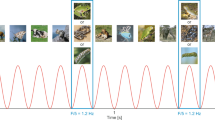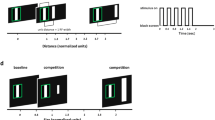Abstract
Rattlesnakes perceive IR radiation with their pit organs. This enables them to detect and strike towards warm-blooded prey even in the dark. In addition, the IR sense allows rattlesnakes to find places for thermoregulation. Animate objects (e.g., prey) tend to move and thus cause moving IR images across the pit membrane. Even when an object is stationary, scanning head movements of rattlesnakes will result in moving IR images across the pit membrane. We recorded the neuronal activity of IR-sensitive tectal neurons of the rattlesnake Crotalus atrox while stimulating the snakes with an IR source that moved horizontally at various velocities. As long as object velocity was low (angular velocity of ~5°/s) IR-sensitive tectal neurons hardly showed any responses. With increasing object velocity though, neuronal activity reached a maximum at ~50°/s. A further increase in object velocity up to ~120°/s resulted in a slight decrease of neuronal activity. Our results demonstrate the importance of moving stimuli for the snake’s IR detection abilities: in contrast to fast moving objects, stationary or slowly moving objects will not be detected when the snake is motionless, but might be detected by scanning head movements.







Similar content being viewed by others
Abbreviations
- IR:
-
Infrared
- LTTD:
-
Nucleus descendens lateralis nervi trigemini
- RC:
-
Nucleus reticularis caloris
- RF:
-
Receptive field
References
Bakken GS, Colayori SE, Duong T (2012) Analytical methods for the geometric optics of thermal vision illustrated with four species of pitvipers. J Exp Biol 215:2621–2629
Beavers RA (1976) Food habits of the western diamondback rattlesnake, Crotalus atrox, in Texas (Viperidae). Southwest Nat 20:503–515
Blum B, Auker CR, Carpenter DO (1978) A head holder and stereotaxic device for the rattlesnake. Brain Res Bull 3:271–274
Borst A, Euler T (2011) Seeing things in motion: models, circuits, and mechanisms. Neuron 71:974–994
Bullock TH, Diecke F (1956) Properties of an infra-red receptor. J Physiol 134:47–87
Bullock TH, Fox W (1957) The anatomy of the infra-red sense organ in the facial pit of pit vipers. J Cell Sci 3:219–234
Chen Q, Deng H, Brauth SE et al (2012) Reduced performance of prey targeting in pit vipers with contralaterally occluded infrared and visual senses. PLoS ONE 7:e34989
De Cock Buning T (1983) Thresholds of infrared sensitive tectal neurons in Python reticulatus, Boa constrictor and Agkistrodon rhodostoma. J Comp Physiol A 151:461–467
De Cock Buning T, Terashima S, Goris RC (1981a) Crotaline pit organs analyzed as warm receptors. Cell Mol Neurobiol 1:69–85
De Cock Buning T, Terashima S, Goris RC (1981b) Python pit organs analyzed as warm receptors. Cell Mol Neurobiol 1:271–278
Djawdan M (1988) Maximal running speeds of bipedal and quadrupedal rodents. J Mammal 69:765–772
Ebert J, Westhoff G (2006) Behavioural examination of the infrared sensitivity of rattlesnakes (Crotalus atrox). J Comp Physiol A 192:941–947
Eskew EA, Willson JD, Winne CT (2009) Ambush site selection and ontogenetic shifts in foraging strategy in a semi-aquatic pit viper, the Eastern cottonmouth. J Zool 277:179–186
Goris RC, Nomoto M (1967) Infrared reception in oriental crotaline snakes. Comp Biochem Physiol 23:879–892
Goris RC, Terashima S (1973) Central response to infra-red stimulation of the pit receptors in a crotaline snake, Trimeresurus flavoviridis. J Exp Biol 58:59–76
Gracheva EO, Ingolia NT, Kelly YM et al (2010) Molecular basis of infrared detection by snakes. Nature 464:1006–1011
Gruberg ER, Kicliter E, Newman EA et al (1979) Connections of the tectum of the rattlesnake Crotalus viridis: an HRP study. J Comp Neurol 188:31–41
Harris JF, Gamow RI (1971) Snake infrared receptors: thermal or photochemical mechanism? Science 172:1252–1253
Hartline PH, Kass L, Loop MS (1978) Merging of modalities in the optic tectum: infrared and visual integration in rattlesnakes. Science 199:1225–1229
Heiligenberg W, Rose GJ (1987) The optic tectum of the gymnotiform electric fish, Eigenmannia: labeling of physiologically identified cells. Neuroscience 22:331–340
Kardong, Bels (1998) Rattlesnake strike behavior: kinematics. J Exp Biol 201:837–850
Kardong KV, Mackessy SP (1991) The strike behavior of a congenitally blind rattlesnake. J Herpetol 25:208–211
Kishida R, Amemiya F, Kusunoki T, Terashima S (1980) A new tectal afferent nucleus of the infrared sensory system in the medulla oblongata of Crotaline snakes. Brain Res 195:271–279
Kohl T, Colayori SE, Westhoff G, Bakken GS, Young BA (2012) Directional sensitivity in the thermal response of the facial pit in western diamondback rattlesnakes (Crotalus atrox). J Exp Biol 215:2630–2636
Kohl T, Bothe MS, Luksch H, Straka H, Westhoff G (2014) Organotopic organization of the primary infrared sensitive nucleus (LTTD) in the western diamondback rattlesnake (Crotalus atrox). J Comp Neurol 522(18):3943–3959
Krochmal AR, Bakken GS (2003) Thermoregulation in the pits: use of thermal radiation for retreat site selection by rattlesnakes. J Exp Biol 206:2539–2545
Lynn WG (1931) The structure and function of the facial pit of the pit vipers. Am J Anat 49:97–139
Marasco PD, Catania KC (2007) Response properties of primary afferents supplying Eimer’s organ. J Exp Biol 210:765–780
Moiseenkova V, Bell B, Motamedi M, Wozniak E, Christensen B (2003) Wide-band spectral tuning of heat receptors in the pit organ of the copperhead snake (Crotalinae). Am J Physiol Integr Comp Physiol 284:598–606
Molenaar GJ (1974) An additional trigeminal system in certain snakes possessing infrared receptors. Brain Res 78:340–344
Newman EA, Hartline PH (1981) Integration of visual and infrared information in bimodal neurons in the rattlesnake optic tectum. Science 213:789–791
Newman EA, Gruberg ER, Hartline PH (1980) The infrared trigemino-tectal pathway in the rattlesnake and in the python. J Comp Neurol 191:465–477
Noble GK, Schmidt A (1937) The structure and function of the facial and labial pits of snakes. Proc Am Phil Soc 77:263–288
Schroeder DM, Loop MS (1976) Trigeminal projections in snakes possessing infrared sensitivity. J Comp Neurol 169:1–11
Shine R, Li-Xin S (2002) Arboreal ambush site selection by pit-vipers Gloydius shedaoensis. Anim Behav 63:565–576
Shine R, Sun L, Kearney M, Fitzgerald M (2002) Why do Juvenile Chinese pit-vipers (Gloydius shedaoensis) select arboreal ambush sites? Ethology 108:897–910
Shine R, Sun L, Kearney M, Fitzgerald M (2006) Thermal correlates of foraging-site selection by Chinese pit-vipers (Gloydius shedaoensis, Viperidae). J Therm Biol 27:405–412
Terashima S, Goris RC (1976) Receptive area of an infrared tectal unit. Brain Res 101:155–159
Terashima S, Goris RC (1979) Receptive areas of primary infrared afferent neurons in crotaline snakes. Neuroscience 4:1137–1144
Terashima S, Goris RC, Katsuki Y (1968) Generator potential of crotaline snake infrared receptor. J Neurophysiol 31:682–688
Van Dyke JU, Grace MS (2010) The role of thermal contrast in infrared-based defensive targeting by the copperhead, Agkistrodon contortrix. Anim Behav 79:993–999
Wagner H, Takahashi T (1990) Neurons in the midbrain of the barn owl are sensitive to the direction of apparent acoustic motion. Naturwissenschaften 77:439–442
Zittlau KE, Class B, Münz H (1986) Directional sensitivity of lateral line units in the clawed toad Xenopus laevis Daudin. J Comp Physiol A 158:469–477
Acknowledgments
We thank Slawa Braun for animal care and Joachim Mogdans and Vera Schlüssel for critical reading of the manuscript. We also thank two anonymous reviewers for carefully reading and commenting on the manuscript. The authors acknowledge the financial support provided by the DFG (KO4835/1-1). Care and maintenance of experimental animals followed the guidelines for reptiles and venomous snakes. Animal housing and experiments were approved by the LANUVNRW (50.203.2-BN 7, 5/03).
Author information
Authors and Affiliations
Corresponding author
Ethics declarations
Conflict of interest
The authors declare that they have no conflict of interests.
Rights and permissions
About this article
Cite this article
Kaldenbach, F., Bleckmann, H. & Kohl, T. Responses of infrared-sensitive tectal units of the pit viper Crotalus atrox to moving objects. J Comp Physiol A 202, 389–398 (2016). https://doi.org/10.1007/s00359-016-1076-1
Received:
Revised:
Accepted:
Published:
Issue Date:
DOI: https://doi.org/10.1007/s00359-016-1076-1




